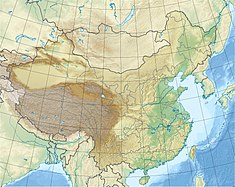|
Baishan Dam
The Baishan Dam (Chinese: 白山大坝, meaning: "White Mountain Dam") is an arch-gravity dam on the Second Songhua River near the town of Baishanzhen, Huadian, Jilin Province, China. The purpose of the dam is hydroelectric power generation and flood control. The dam supplies water to five turbine-generators in two different powerhouses for an installed capacity of 1,500 megawatts (2,000,000 hp) while it can also control a design 19,100 cubic metres per second (670,000 cu ft/s) flood. Additionally, it has a 300 megawatts (400,000 hp) pumped-storage hydroelectric generation capacity. It is named after Baekdu Mountain (White Mountain), near the city of Baishan. ConstructionConstruction on the dam began in May 1975, the reservoir began to fill on September 16, 1982 and by the end of 1984, the first phase of three generators was operational. Another two generators in the project's second phase were operational by 1992.[1] The dam submerged an area of 17.67 square kilometres (6.82 sq mi), displacing about 10,300 people.[2] In March 2000, a feasibility study report on a pumped-storage capability for the dam was approved. In August 2002, construction started on installing two 150 MW reversible pump generators and by July 2006, they were operational.[3] DesignThe Baishan Dam is a 149.5 metres (490 ft) tall and 677.5 metres (2,223 ft) long arch gravity dam composed of 1,663,000 cubic metres (58,700,000 cu ft) of concrete.[4] It withholds a 6,500,000,000 cubic metres (5,300,000 acre⋅ft) reservoir of which 3,540,000,000 cubic metres (2,870,000 acre⋅ft) is active or "useful" storage and 950,000,000 cubic metres (770,000 acre⋅ft) is flood storage. The dam's spillway contains four 12 by 13 metres (39 ft × 43 ft) openings and three 6 by 7 metres (20 ft × 23 ft) mid-level openings on its orifice.[1] All the dam's openings can discharge a design of 19,100 cubic metres per second (670,000 cu ft/s), check standard of 26,200 cubic metres per second (930,000 cu ft/s) and maximum of 32,200 cubic metres per second (1,140,000 cu ft/s) of water.[2] The dam powers three separate power stations. The first station to be constructed is located underground and contains 3 x 300 MW Francis turbine generators while the second, located on the left bank slightly downstream contains 2 x 300 MW Francis turbine generators.[1] The third portion of the dam's power station is 2 x 150 MW pump-generators. The dam's current reservoir serves as the upper and the Hongshi Dam's reservoir downstream serves as the lower.[3] See alsoReferences
|
||||||||||||||||||||||||||||||||||||||||||||||||||||||
